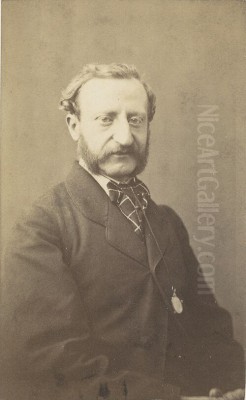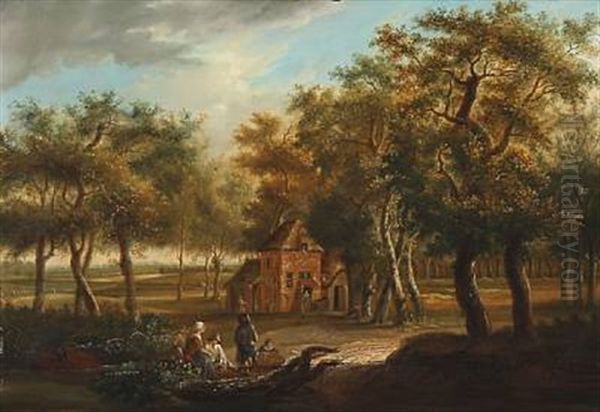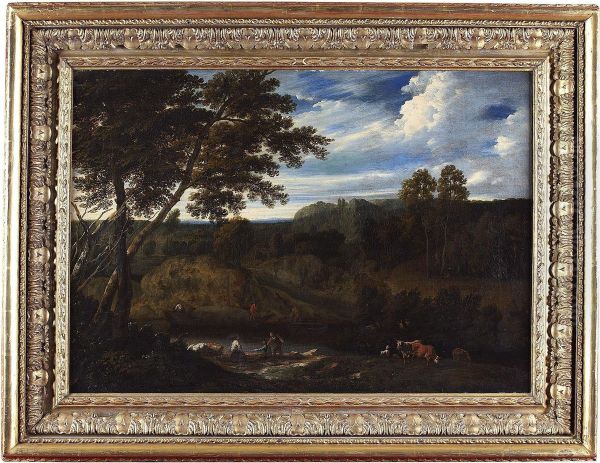
The annals of art history occasionally present figures whose identities become intertwined, sometimes due to shared names across generations or simple confusion in records. Jan Baptist Huysmans is one such name, representing at least two distinct Flemish artists active centuries apart. This exploration primarily focuses on the Jan Baptist Huysmans born in the mid-17th century, a landscape painter working within the rich traditions of the Southern Netherlands, while also acknowledging the existence of a later namesake to clarify historical records and address information often conflated across sources. Understanding this earlier Huysmans requires placing him within the vibrant artistic milieu of Antwerp and Brussels during the Baroque era, examining his training, style, influences, and relationship with contemporaries, particularly his more renowned brother, Cornelis Huysmans.
The Artistic Landscape of the Southern Netherlands
The 17th century was a period of immense artistic production in the Southern Netherlands, roughly corresponding to modern-day Belgium. Despite political and economic challenges following the separation from the Northern Provinces (the Dutch Republic), cities like Antwerp and Brussels remained significant cultural centers. Antwerp, in particular, had been the powerhouse of Flemish painting in the earlier part of the century, dominated by the towering figure of Peter Paul Rubens (1577-1640). Rubens's dynamic compositions, rich colors, and energetic brushwork set a standard and influenced generations.
Following Rubens, artists like Anthony van Dyck (1599-1641), primarily known for portraiture but also a master of religious and mythological scenes, and Jacob Jordaens (1593-1678), known for his robust genre scenes and large-scale works, continued Antwerp's artistic legacy. Landscape painting also flourished, evolving from the earlier, more fantastical world landscapes of Joachim Patinir (c. 1480-1524) and the detailed woodland scenes of Gillis van Coninxloo (1544-1607) towards more naturalistic representations, though often imbued with an idealized or pastoral quality. Artists like Jan Brueghel the Elder (1568-1625) and his son Jan Brueghel the Younger (1601-1678) were famed for their detailed landscapes and flower paintings, often collaborating with figures like Rubens. Lucas van Uden (1595-c. 1672) developed a style influenced by Rubens's approach to landscape. It was into this environment, rich with established traditions and ongoing innovation, that Jan Baptist Huysmans was born.
Early Life and Artistic Formation

Jan Baptist Huysmans entered the world in Antwerp, baptized on October 7, 1654. He hailed from a family with artistic inclinations. His father, Hendrick Huysmans, was a blockmaker and schoolmaster, suggesting a background connected to crafts and education. More significantly for Jan Baptist's path, his elder brother was Cornelis Huysmans (1648-1727), who would become a well-regarded landscape painter, often known as "Huysmans of Mechelen" due to his later association with that city, although he also worked extensively in Antwerp and Brussels.
It is highly likely that Jan Baptist received his initial artistic training alongside or directly from his brother Cornelis. The familial connection often played a crucial role in artistic education during this period. However, sources indicate that Jan Baptist further honed his skills in Brussels. There, he is documented as having studied under Jacques d'Arthois (1613-1686). D'Arthois was a prominent landscape painter based in Brussels, known for his large-scale, decorative woodland scenes, often characterized by dense foliage, winding paths, and a somewhat formulaic but effective composition. His workshop was prolific, and studying with him would have immersed Jan Baptist in the prevailing style of Brussels landscape painting, which often emphasized decorative qualities suitable for large interiors.
Some sources also mention Gaspard de Wit (1621-1674) as a teacher, an Antwerp painter known more for historical and religious subjects, though landscape elements often featured in his work. If this association is accurate, it might suggest a broader training than landscape alone, potentially explaining the religious themes sometimes attributed to Jan Baptist. Another source mentions a move to Holland in 1672 for further study, though details remain scarce. This period would have exposed him to the distinct traditions of Dutch landscape painting, which often emphasized realism and specific local topographies, contrasting somewhat with the more idealized or Italianate tendencies sometimes found in Flemish landscapes.
Artistic Style: Landscapes, Influences, and Comparisons
Jan Baptist Huysmans primarily dedicated himself to landscape painting, following the path of his brother and his teacher, d'Arthois. His works typically depict wooded scenes, often featuring paths, clearings, and sometimes small figures that serve to animate the composition and provide scale. These figures are generally staffage – generic additions rather than specific narrative elements – common in landscape painting of the era.
His style reflects the influences he absorbed. The impact of Jacques d'Arthois is visible in the compositional structures, often featuring prominent tree groups framing a receding view. The dense rendering of foliage and the somewhat decorative approach to nature echo his master's manner. However, Jan Baptist's work is generally considered distinct from that of d'Arthois, perhaps softer in execution or differing in palette.

A significant point of comparison is inevitably his brother, Cornelis Huysmans. Cornelis developed a more distinctive and highly regarded style, often characterized by a warmer palette, a more dynamic handling of light, and a greater sense of atmosphere, sometimes showing an affinity for Italianate landscapes influenced by artists like Claude Lorrain or Gaspard Dughet, though rooted in Flemish tradition. Art historical consensus, reflected even in early biographical accounts like those by Arnold Houbraken or Jean-Baptiste Descamps, generally positions Jan Baptist as a competent painter but less talented or original than Cornelis. His technique was sometimes described as drier or less refined than his brother's.
The provided source material mentions an influence from the "Venetian school" and suggests Jan Baptist attempted to imitate this style, albeit with limited success compared to his brother. This is an interesting observation. Venetian painting, particularly the works of Titian (c. 1488/1490-1576) and his followers, was renowned for its rich colorito (emphasis on color and brushwork) and atmospheric effects, especially in landscape backgrounds. While direct Venetian influence on a late 17th-century Flemish landscape painter might seem less common than Italianate influence via Rome (like Claude Lorrain), it's possible that certain aspects – perhaps a warmer palette or a focus on light and color – were perceived as Venetian-inspired. However, the assessment that he was "less successful" in this than Cornelis suggests his attempts might have been superficial or not fully integrated into his core Flemish style.
Beyond pure landscapes, some sources attribute religious subjects and even still lifes, particularly flower paintings, to Jan Baptist Huysmans. The inclusion of religious themes is plausible, given the prevalence of religious art in the Southern Netherlands and a possible connection to Gaspard de Wit. However, the attribution of flower still lifes needs careful consideration. While diversification was possible, flower painting was a highly specialized genre dominated by figures like Jan Brueghel the Elder, Daniel Seghers (1590-1661), and later, the exceptionally famous Jan van Huysum (1682-1749) in the Dutch Republic. Confusion with Jan van Huysum, or perhaps with the later Jan Baptist Huysmans, might account for some of these attributions. The 17th-century Jan Baptist's primary focus and reputation firmly rest on landscape.
Representative Works and Collections

Identifying specific, securely attributed works by Jan Baptist Huysmans can be challenging due to potential confusion with his brother and the general similarity of workshop productions in the d'Arthois circle. However, some paintings are associated with him. The provided text mentions one specific title: Wooded landscape with four figures sitting in the foreground. This title is typical of his oeuvre, describing a scene focused on nature, populated by incidental figures. Such works would likely showcase his handling of trees, foliage, light filtering through leaves, and the creation of spatial depth through receding paths or vistas.
His paintings often feature a relatively dark foreground, leading the eye towards a brighter middle ground or background, a common compositional device in Baroque landscape. The rendering of trees, with attention to bark texture and leaf patterns, would be characteristic, likely reflecting the detailed approach learned from the Flemish tradition and potentially influenced by d'Arthois. The figures, as mentioned, would typically be small and integrated into the landscape setting rather than dominating it.
Museums in Brussels and Antwerp are cited as holding works by Jan Baptist Huysmans. This aligns with his known areas of activity. The Royal Museums of Fine Arts of Belgium in Brussels and the Royal Museum of Fine Arts Antwerp (KMSKA) are logical repositories for works by Flemish artists of this period. Attributions in museum collections are generally subject to ongoing research, but the presence of works under his name in these institutions confirms his recognition within the Flemish school. Examining these attributed works allows for a more direct assessment of his style, technique, and artistic merit relative to his contemporaries.
Interactions and Context: The Huysmans Brothers and Contemporaries
The most significant artistic relationship for Jan Baptist was undoubtedly with his brother, Cornelis Huysmans. They shared a common artistic heritage and likely trained together initially. Jan Baptist's style is often seen as closely related to, or even imitating, Cornelis's manner, particularly in his earlier phases. While Jan Baptist may not have achieved the same level of recognition, the brothers operated within the same artistic circles in Antwerp and Brussels. It's conceivable they might have collaborated or shared workshop resources at times, although specific documentation of joint projects is lacking. Their careers ran parallel for several decades, both contributing to the landscape genre in the late Baroque period.
His connection to Jacques d'Arthois places him within a major Brussels workshop. This environment would have involved interaction with other pupils and assistants of d'Arthois. One such figure associated with d'Arthois was Adriaen Frans Boudewijns (1644-1711), another Brussels landscape painter who sometimes collaborated with other artists, having them paint the figures (staffage) in his landscapes. While direct collaboration between Huysmans and Boudewijns isn't explicitly documented, they were contemporaries working in the same city and genre, likely aware of each other's work.
The broader artistic scene included numerous other landscape painters. In Antwerp, the influence of earlier masters like Jan Wildens (1586-1653) and the aforementioned Lucas van Uden persisted. In Brussels, besides d'Arthois and his circle, other landscape traditions continued. The context also included painters specializing in different genres who were nonetheless part of the same artistic community, such as the genre painter David Teniers the Younger (1610-1690), who was highly successful and influential in Antwerp and later Brussels. Although their subjects differed, artists often interacted through guilds (like the Guild of Saint Luke, which regulated artists and craftsmen), commissions, and the art market.
While Jan Baptist Huysmans may not have been a leading innovator, he was part of this active network. His work represents a continuation of the established Flemish landscape tradition, modified by the specific influence of his brother and his master, d'Arthois, and potentially reflecting broader trends like the enduring appeal of Italianate or pastoral elements within landscape painting. His career unfolded in the shadow of giants like Rubens and Van Dyck, but within the specific niche of landscape painting, he contributed alongside figures like his brother and the d'Arthois school. Other notable Flemish painters active during parts of his lifetime include Abraham Genoels II (1640-1723), another landscape painter who worked in Antwerp and later Rome, and figures associated with the Brueghel dynasty's enduring legacy in detailed landscape and genre scenes.
The Conflation: A Later Jan Baptist Huysmans
Compounding the challenge of understanding the 17th-century landscape painter is the existence of another artist named Jan Baptist Huysmans (1826-1906). This later artist was active primarily in the 19th century and is best known for his Orientalist paintings – scenes inspired by travels in North Africa and the Middle East. His style and subject matter are entirely different from his 17th-century namesake, belonging to the academic and Orientalist movements of his own era.
The confusion between these two artists likely explains some discrepancies found in biographical sources. For instance, the provided Chinese text mentions a house fire in 1908 linked to "Jan Baptist Huysmans" and possibly "superstitious activities." This date falls after the death of the 19th-century Orientalist painter (d. 1906) and centuries after the death of the 17th-century landscape painter (d. 1716). This suggests either a mistake in the date, a reference to the estate or legacy of the later Huysmans, or perhaps confusion with yet another individual. However, the association of a 20th-century event with the name clearly points away from the 17th-century artist. Similarly, the unusually late death date of 1757 mentioned in one part of the source text for a Jan Baptist Huysmans is inconsistent with the established death year of 1716 for the 17th-century landscape painter; it might stem from this conflation or other transcription errors over time.
It is crucial for art historical clarity to firmly distinguish between Jan Baptist Huysmans (1654-1716), the Baroque landscape painter, and Jan Baptist Huysmans (1826-1906), the 19th-century Orientalist painter. Their oeuvres, contexts, and historical significance are entirely separate.
Further Distinction: Jan van Huysum
The source material also correctly notes the need to differentiate Jan Baptist Huysmans from another famous artist with a similar surname: Jan van Huysum (1682-1749). Jan van Huysum was a Dutch painter, active primarily in Amsterdam during the 18th century. He was the son of the painter Justus van Huysum the Elder (1659-1716), who also specialized in flower painting.
Jan van Huysum achieved extraordinary fame for his flower still lifes, and to a lesser extent, landscapes. His flower paintings are characterized by meticulous detail, brilliant colors, complex compositions often featuring classical urns and garden settings, and an almost unparalleled ability to render the textures of petals, leaves, and dewdrops. He often combined flowers from different seasons into a single bouquet, creating idealized, luxurious arrangements that were highly sought after by collectors across Europe. His technique involved smooth, often invisible brushwork and careful layering of glazes.
The source text mentions that Jan van Huysum had only one documented pupil, Margaretha Haverman (fl. 1716-1723), who herself became a skilled flower painter. While Jan Baptist Huysmans (the 17th-century Fleming) was a landscape painter working in a different country and time period, the similarity in names (Huysmans vs. Huysum) and the occasional, possibly erroneous, attribution of still lifes to Jan Baptist Huysmans make this distinction important. Jan van Huysum represents the pinnacle of Dutch flower painting in the 18th century, a very different artistic profile from the Flemish Baroque landscapist Jan Baptist Huysmans.
Legacy and Historical Assessment
Jan Baptist Huysmans (1654-1716) occupies a specific place within the history of Flemish art. He was a competent and productive landscape painter working within the established traditions of Antwerp and Brussels during the late Baroque period. His artistic identity is closely tied to his more famous brother, Cornelis, and his teacher, Jacques d'Arthois. While generally considered less innovative or technically brilliant than his brother, his works contribute to our understanding of the landscape genre's development in the Southern Netherlands after the era of Rubens.
His paintings, often depicting serene woodland scenes, reflect the decorative needs and aesthetic preferences of the time. They demonstrate proficiency in composition, the rendering of natural elements like trees and foliage, and the use of light to create atmosphere, even if they sometimes adhered to established formulas. The assessment that he attempted to incorporate Venetian elements, though perhaps not fully successfully, hints at an awareness of broader European artistic trends.
His historical significance is perhaps secondary compared to the leading masters of Flemish painting, but he remains a figure of interest within the specialized field of landscape painting. His works provide valuable examples of the style prevalent in Brussels under d'Arthois and offer a point of comparison with his brother Cornelis, helping to delineate the latter's unique contributions more clearly. The primary challenge in studying Jan Baptist Huysmans remains the careful disentanglement of his life and work from that of his brother, his later namesake the Orientalist painter, and the similarly named Dutch flower painter Jan van Huysum. Accurate attribution and contextualization are key to appreciating his specific contribution to the rich tapestry of Flemish Baroque art. He died in Antwerp in 1716.
Conclusion: A Painter in Context
Jan Baptist Huysmans the elder stands as a representative figure of the generation of Flemish artists active in the late 17th and early 18th centuries. Working primarily in landscape, he navigated the influences of family, teachers, and the broader artistic currents of his time. While overshadowed by his brother Cornelis and the giants who preceded him, his work holds its own within the context of the Brussels and Antwerp schools of landscape painting. His woodland scenes, influenced by Jacques d'Arthois but possessing their own character, contribute to the diversity of the genre. Understanding his career requires acknowledging the complexities introduced by shared names across history, but by focusing on the documented details of his life (1654-1716), his training, and his specific artistic output, we can appreciate Jan Baptist Huysmans as a dedicated landscape painter who played his part in the continuing story of Flemish art. His work invites closer study, not just for its intrinsic qualities, but for the light it sheds on the artistic networks and stylistic developments of his era.